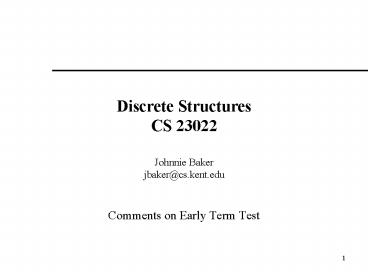Discrete Structures CS 23022 - PowerPoint PPT Presentation
Title:
Discrete Structures CS 23022
Description:
Discrete Structures CS 23022 Johnnie Baker jbaker_at_cs.kent.edu Comments on Early Term Test * Comments on Early Term Exam Know truth tables for the basic constructs ... – PowerPoint PPT presentation
Number of Views:25
Avg rating:3.0/5.0
Title: Discrete Structures CS 23022
1
Discrete StructuresCS 23022
- Johnnie Baker
- jbaker_at_cs.kent.edu
- Comments on Early Term Test
2
Comments on Early Term Exam
- Know truth tables for the basic constructs and,
or, implies, equivalence, exclusive or,
biconditional, etc. - Be able to calculate the truth table for compound
statements. - Understand standard terminology contrapositive,
converse, tautology, contridiction, - Know the various logical equivalences See Table
6-8 in section 1.2 - Know meaning and equivalences involving ? and ?
(universal quanifiers.) and how to negate these
quantifiers. - Be able to translate logic statements into
English statements without variables and symbols.
Conversely, be able to translate English
statements into logic statements. - Be able to verify correctness of reasoning
involving logic statements. - Also, be able to deduce conclusions from logic
statements
3
- Be able to negate nested quantifiers.
- Understand terminology like argument, valid,
premises, fallacies, etc. - Know and be able to use the various rules of
inferences, such as those in Table 1 on pg 66. - Be able to use the rules of inference to make
logical arguments, as in Section 1.5. - Look over added, suggested study odd-nr problems
for Section 1.5, as no assignment was made for
this section 3,9,13,15,19,23,27,29,31. - Understand how to work with universal and
exitential generalizations and instantiations. - Be able to verify validity of arguments and make
arguments involving these concepts. - In section 1.6, understand the terminology
concerning mathematical proofs such as theorems,
axioms/postulates, proof, etc.
4
- In Section 1.6, understand the various methods of
proving theorems. - Be able to use the various methods for proving
theorems to establish correctness of mathematical
statements. - Also, be able to identify errors in the proof of
mathematical or logic arguments. - Be able to establish show a mathematical
statement is false using a counterexample. - Understand mathematical terminology introduced in
material covered, such as integer, rational,
irrational, odd, even, - Know the difference between constructive and
non-constructive proofs.
5
Sets
- Understand set terminology such as set builder
notation, and be able to use it. - Know meaning of standard sets like N, Z, Q, R,
- Understand standard set theory terminology, e.g.,
element, subset, cartesian product, universal
set, set difference, etc. - Know standard set operations and be able to use
them. - Know the standard set identities such as Table 1
on pg 124. - Be able to prove set identities such as (A?B)
A ? B, and give reasons for all steps. - Be able to use a truth table to establish set
identities.































